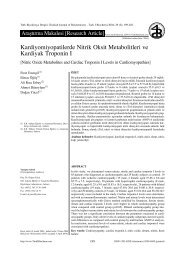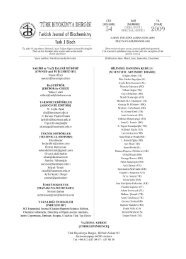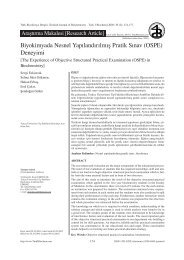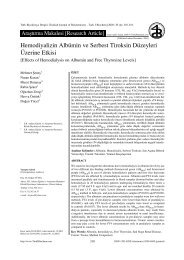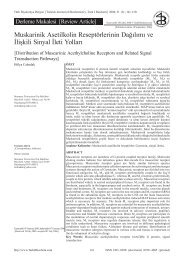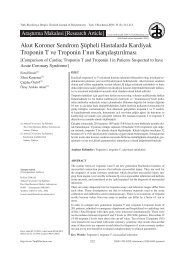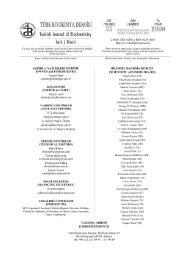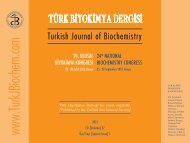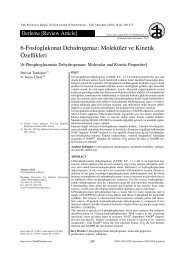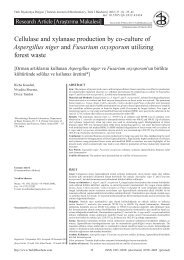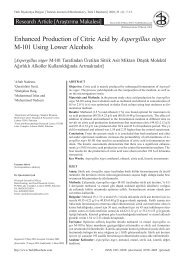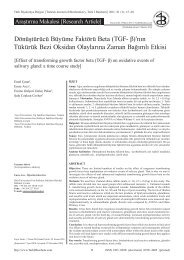Effects of Storage Conditions on Complete Blood Cell Count ...
Effects of Storage Conditions on Complete Blood Cell Count ...
Effects of Storage Conditions on Complete Blood Cell Count ...
Create successful ePaper yourself
Turn your PDF publications into a flip-book with our unique Google optimized e-Paper software.
Introducti<strong>on</strong><br />
Laboratory practices carried out by centralized laboratories<br />
make it critical to know the specimen storage<br />
c<strong>on</strong>diti<strong>on</strong>s well. Transport <str<strong>on</strong>g>of</str<strong>on</strong>g> collected blood specimens<br />
to centralized laboratories can lead to a delay in testing<br />
for several hours. <strong>Cell</strong>ular elements are known to have<br />
a limited stability in blood c<strong>on</strong>taining ethylenediamine<br />
tetraacetate (EDTA) [1]. Excessive delays in processing,<br />
however, might compromise the reliability <str<strong>on</strong>g>of</str<strong>on</strong>g> results. Limited<br />
number <str<strong>on</strong>g>of</str<strong>on</strong>g> studies have been c<strong>on</strong>ducted with all<br />
the currently used hematology analyzers for the effects<br />
<str<strong>on</strong>g>of</str<strong>on</strong>g> storage <strong>on</strong> analysis [2-4]. Delays in analysis may have<br />
caused different results in both normal and pathological<br />
specimens [2].<br />
Manufacturers <str<strong>on</strong>g>of</str<strong>on</strong>g> automated analyzers and published<br />
literature <str<strong>on</strong>g>of</str<strong>on</strong>g>ten state that blood specimens, kept at either<br />
room temperature or at +4 o C (refrigerated) for up to<br />
24 hours, generally reveal reliable results for <strong>Complete</strong><br />
<strong>Blood</strong> <strong>Cell</strong> <strong>Count</strong> (CBC) [2-4]. However, these studies<br />
may not be satisfactory as the high variety <str<strong>on</strong>g>of</str<strong>on</strong>g> analyzers<br />
used are c<strong>on</strong>sidered. Besides, no c<strong>on</strong>sensus was reached<br />
about which paremeters can still be reliable in delays<br />
over 24 hours when the analyzers were out <str<strong>on</strong>g>of</str<strong>on</strong>g> order due<br />
to different reas<strong>on</strong>s [2-4,6].<br />
In order to decide whether to accept or reject the aged<br />
specimen, laboratory staff needs to be familiar with the<br />
changes known to occur in blood specimens during storage<br />
[3].<br />
In the present study, Beckman Coulter Gen–S (COUL-<br />
TER Corp, Miami, USA) hematology analyzer was used<br />
in order to compare the stability <str<strong>on</strong>g>of</str<strong>on</strong>g> normal and pathological<br />
blood specimens collected in K 2<br />
EDTA tubes and<br />
stored at +4 o C and +25 o C up to 48 hours and evaluated if<br />
there is an advantage <str<strong>on</strong>g>of</str<strong>on</strong>g> storing at +4 o C.<br />
Materials and Methods<br />
A total <str<strong>on</strong>g>of</str<strong>on</strong>g> 117 randomly selected K 2<br />
EDTA anticoagulated<br />
blood specimens were processed through the Coulter<br />
Gen S hematology analyzer at Ankara Numune<br />
Educati<strong>on</strong> and Research Hospital Emergency Biochemistry<br />
Laboratories. Two specimens were taken from<br />
each patient into two separate tubes. Am<strong>on</strong>g the 117<br />
specimens; 48 <str<strong>on</strong>g>of</str<strong>on</strong>g> them were normal, 14 <str<strong>on</strong>g>of</str<strong>on</strong>g> them were<br />
leukopenic (white cell count, 11.0 x 10 3 /µL), 19<br />
<str<strong>on</strong>g>of</str<strong>on</strong>g> them were thrombocytopenic (platelet count, 400 x 10 3 /µL). <strong>Blood</strong> specimens were kept<br />
at either room temperature or in refrigerator prior to<br />
analysis up to 48 hours.<br />
Each sample was drawn into 4 mL capacity K 2<br />
EDTA<br />
BD Vacutainer tubes. Each sample was analyzed at<br />
time point <str<strong>on</strong>g>of</str<strong>on</strong>g>



